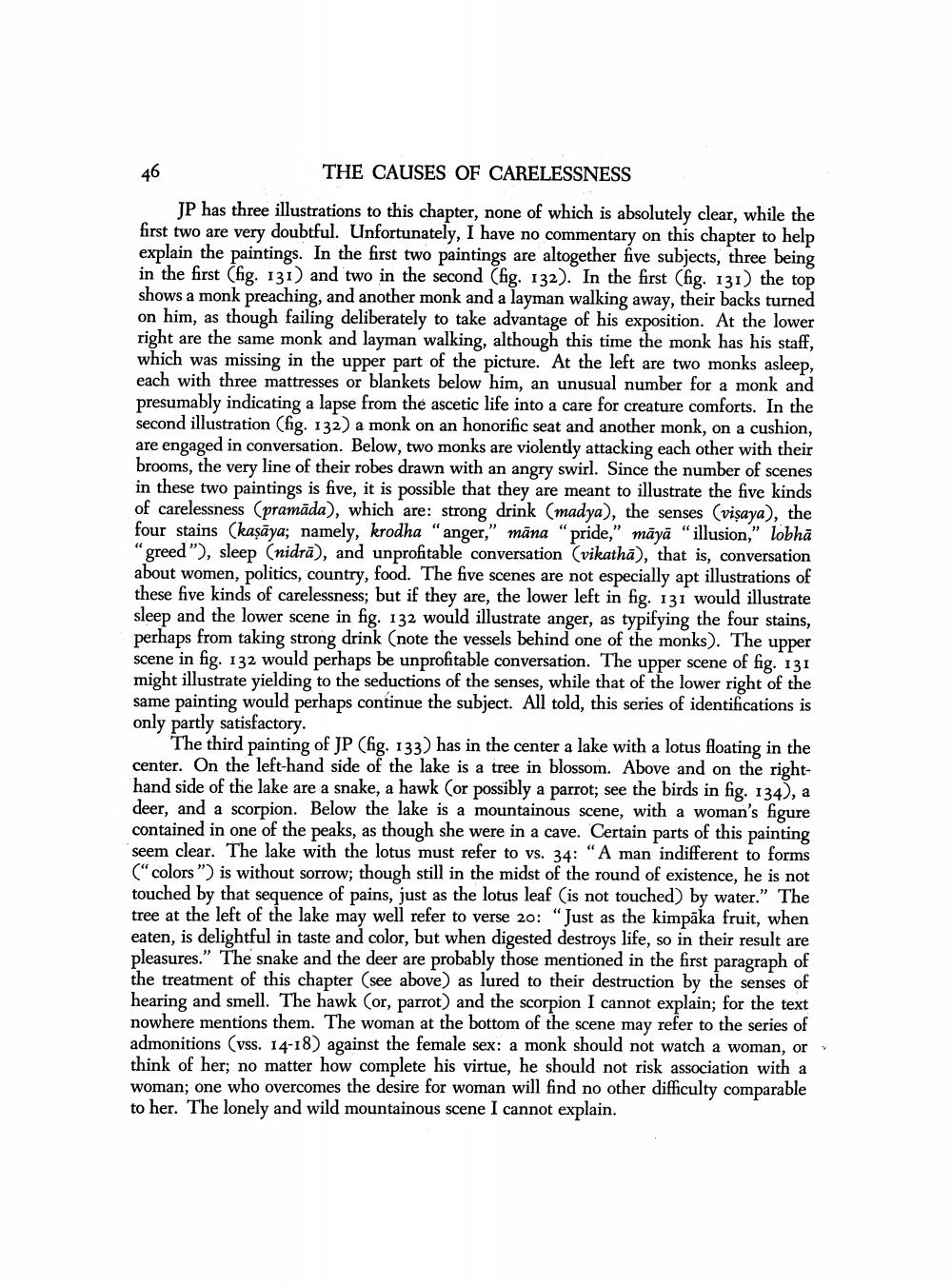________________
96
THE CAUSES OF CARELESSNESS JP has three illustrations to this chapter, none of which is absolutely clear, while the first two are very doubtful. Unfortunately, I have no commentary on this chapter to help explain the paintings. In the first two paintings are altogether five subjects, three being in the first (fig. 131) and two in the second (fig. 132). In the first (fig. 131) the top shows a monk preaching, and another monk and a layman walking away, their backs turned on him, as though failing deliberately to take advantage of his exposition. At the lower right are the same monk and layman walking, although this time the monk has his staff, which was missing in the upper part of the picture. At the left are two monks asleep, each with three mattresses or blankets below him, an unusual number for a monk and presumably indicating a lapse from the ascetic life into a care for creature comforts. In the second illustration (fig. 132) a monk on an honorific seat and another monk, on a cushion, are engaged in conversation. Below, two monks are violently attacking each other with their brooms, the very line of their robes drawn with an angry swirl. Since the number of scenes in these two paintings is five, it is possible that they are meant to illustrate the five kinds of carelessness (pramāda), which are: strong drink (madya), the senses (visaya), the four stains (kaşāya; namely, krodha "anger," māna "pride," māyā “illusion," lobhā "greed"), sleep (nidrā), and unprofitable conversation (vikathā), that is, conversation about women, politics, country, food. The five scenes are not especially apt illustrations of these five kinds of carelessness; but if they are, the lower left in fig. 131 would illustrate sleep and the lower scene in fig. 132 would illustrate anger, as typifying the four stains, perhaps from taking strong drink (note the vessels behind one of the monks). The upper scene in fig. 132 would perhaps be unprofitable conversation. The upper scene of fig. 131 might illustrate yielding to the seductions of the senses, while that of the lower right of the same painting would perhaps continue the subject. All told, this series of identifications is only partly satisfactory.
The third painting of JP (fig. 133) has in the center a lake with a lotus floating in the center. On the left-hand side of the lake is a tree in blossom. Above and on the righthand side of the lake are a snake, a hawk (or possibly a parrot; see the birds in fig. 134), a deer, and a scorpion. Below the lake is a mountainous scene, with a woman's figure contained in one of the peaks, as though she were in a cave. Certain parts of this painting seem clear. The lake with the lotus must refer to vs. 34: "A man indifferent to forms ("colors") is without sorrow; though still in the midst of the round of existence, he is not touched by that sequence of pains, just as the lotus leaf (is not touched) by water." The tree at the left of the lake may well refer to verse 20: "Just as the kimpāka fruit, when eaten, is delightful in taste and color, but when digested destroys life, so in their result are pleasures.” The snake and the deer are probably those mentioned in the first paragraph of the treatment of this chapter (see above) as lured to their destruction by the senses of hearing and smell. The hawk (or, parrot) and the scorpion I cannot explain; for the text nowhere mentions them. The woman at the bottom of the scene may refer to the series of admonitions (vss. 14-18) against the female sex: a monk should not watch a woman, or think of her; no matter how complete his virtue, he should not risk association with a woman; one who overcomes the desire for woman will find no other difficulty comparable to her. The lonely and wild mountainous scene I cannot explain.
deer, and a score of the peaks, as thus must refer to y of the ro




